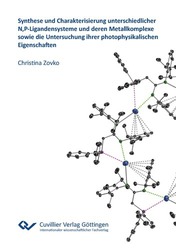| Areas | |
|---|---|
| Serie de libros (96) |
1378
|
| Nachhaltigkeit |
3
|
| Gesundheitswesen |
1
|
| Letra |
2365
|
| Ciencias Naturales |
5406
|
| Matemática | 229 |
| Informática | 319 |
| Física | 980 |
| Química | 1363 |
| Geociencias | 131 |
| Medicina humana | 243 |
| Estomatología | 10 |
| Veterinaria | 108 |
| Farmacia | 147 |
| Biología | 835 |
| Bioquímica, biología molecular, tecnología genética | 121 |
| Biofísica | 25 |
| Nutrición | 45 |
| Agricultura | 1004 |
| Silvicultura | 201 |
| Horticultura | 20 |
| Ecología y conservación de la tierra | 148 |
| Ciencias Ingeniería |
1793
|
| General |
98
|
|
Leitlinien Unfallchirurgie
5. Auflage bestellen |
|
Erweiterte Suche
Synthese und Charakterisierung unterschiedlicher N,P-Ligandensysteme und deren Metallkomplexe sowie die Untersuchung ihrer photophysikalischen Eigenschaften (Tienda española)
Christina Zovko (Autor)Previo
Lectura de prueba, PDF (700 KB)
Indice, PDF (82 KB)
Diese Dissertation beschreibt u.a. die Synthese und Charakterisierung neuartiger P,N-Ligandensysteme sowie deren Metallkomplexe, wobei ein besonderer Fokus auf den photophysikalischen Eigenschaften der Komplexe lag. Hierfür wurden drei unterschiedliche bifunktionelle Ligandensysteme, welche sowohl Stickstoff- als auch Phosphan bzw. Phosphansulfid-Funktionalitäten besitzen, synthetisiert. Als neuartige Liganden wurden ein Triarylphosphan-funktionalisiertes ß-Diketimin (PNac-H), ein Phosphan-funktionalisierter Amidin-Ligand (DPPM-C(N-Dipp)2H) sowie ein Phosphan- bzw. Phosphansulfid-funktionalisiertes BIAN-Ligandensystem ((S)PPh2-BIAN) realisiert. Aufgrund der unterschiedlichen Donorstellen (harte Stickstoff- und weiche Phosphan-Einheiten) der entsprechenden Liganden konnten mittels Metallkoordination unterschiedliche Koordinationspolyeder aufgebaut sowie selektive Metallkoordinationen realisiert werden. Die dargestellten P,N-Systeme erwiesen sich demnach als geeignete, multifunktionale Liganden zum Aufbau von mono- und bimetallischen Komplexen. Die spezifische Struktur des PNac-Ligandensystems ermöglichte u.a. die Stabilisierung einer reaktiven, subvalenten Ni(I)-Spezies, welche nachfolgend hinsichtlich ihrer Reaktivität und der Aktivierung kleiner Moleküle untersucht wurde. Für ausgewählte Metallkomplexe wurden zudem deren photophysikalischen Eigenschaften näher betrachtet.
| ISBN-13 (Impresion) | 9783736975989 |
| ISBN-13 (E-Book) | 9783736965980 |
| Formato | A5 |
| Idioma | Alemán |
| Numero de paginas | 216 |
| Laminacion de la cubierta | mate |
| Edicion | 1. |
| Lugar de publicacion | Göttingen |
| Lugar de la disertacion | Karlsruhe |
| Fecha de publicacion | 23.03.2022 |
| Clasificacion simple | Tesis doctoral |
| Area |
Química
Química inorgánica |
| Palabras claves | N,P-Ligandensysteme, Metallkomplexe, photophysikalische Eigenschaften, Amidinate, ß-Diketiminate, BIAN, PNac, Alkalimetallkomplexe, Übergangsmetallkomplexe, DPPM-Amidin-Liganden, Photolumineszenz, HSAB, Fluoreszenz-Spektroskopie, Kristallstrukturanalyse, Quantenausbeute, Fluoreszenz, Phosphoreszenz, Phosphane, Lanthanoidkomplexen, multidentate Koordinationssphäre, aurophile Wechselwirkung, Metall-Metall-Wechselwirkung, DPPM, Carbodiimide, bifunktionelle Ligandensysteme, Koordinationsmodi, NMR-Spektroskopie, IR-Spektroskopie, Raman-Spektroskopie, Gold, Silber, Kupfer, Nickel, Platin, Lithium, Cäsium, Molekül-Aktivierung, Heterometallische Komplexe, DOSY-NMR-Spektroskopie, Lanthanoide, N,P-ligand systems, metal complexes, photophysical properties, amidinates, ß-diketiminates, BIAN, P,N-ligands, PNac, alkali metal complexes, transition metal complexes, DPPM-amidine ligands, photoluminescence, HSAB, fluorescence spectroscopy, crystal structure analysis, quantum yield, fluorescence, phosphorescence, phosphanes, lanthanide complexes, multidentate coordination sphere, aurophilic interaction, metal-metal interaction, DPPM, carbodiimide, bifunctional ligand systems, coordination modes, NMR spectroscopy, IR spectroscopy, Raman spectroscopy, gold, silver, copper, nickel, platinum, lithium, caesium, molecule activation, heterometallic complexes, diffusion ordered spectroscopy, lanthanides |








